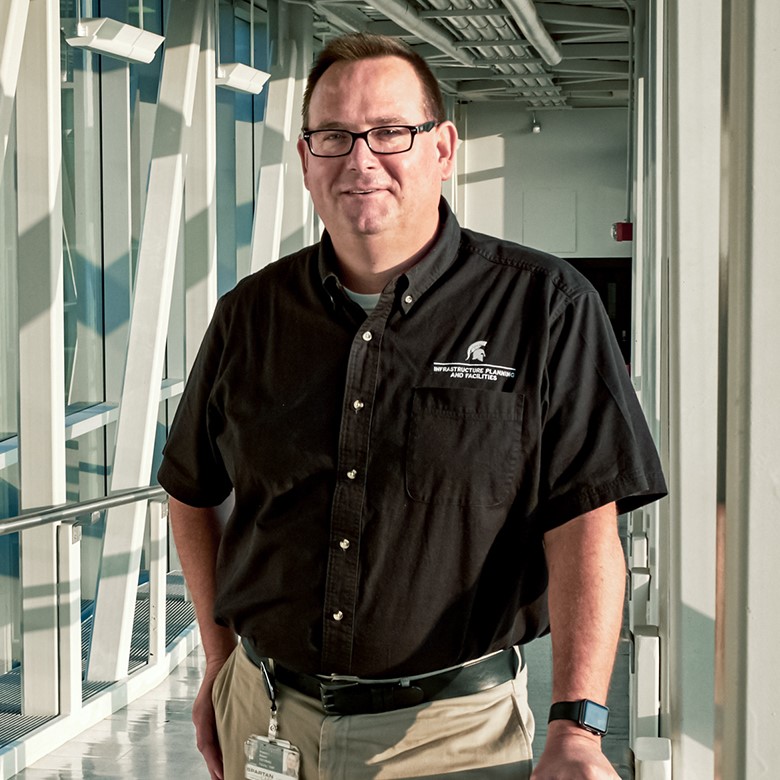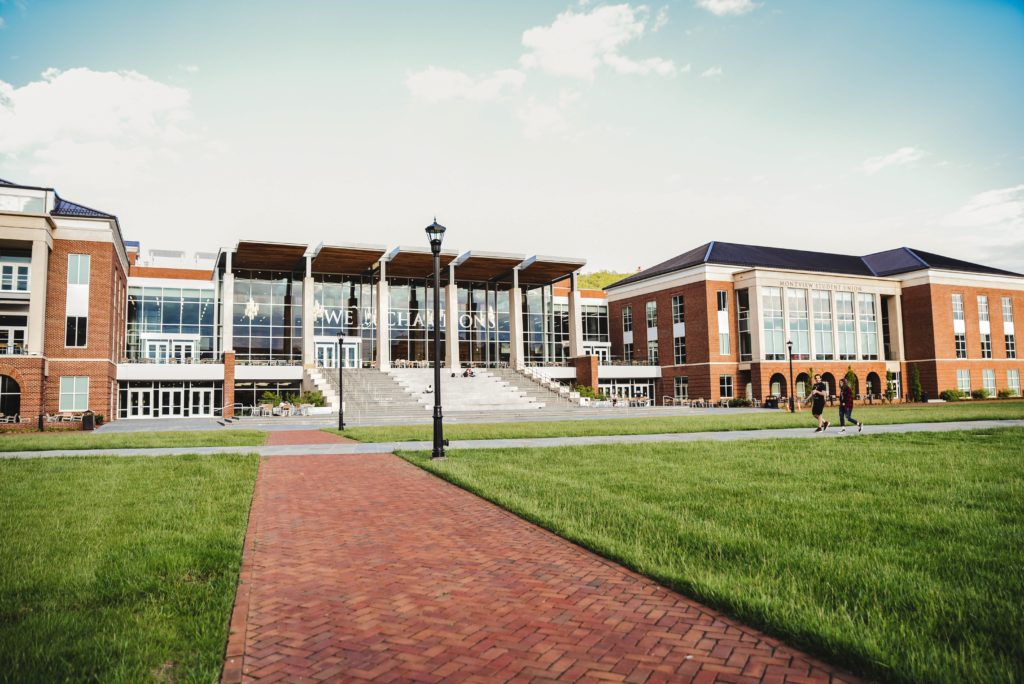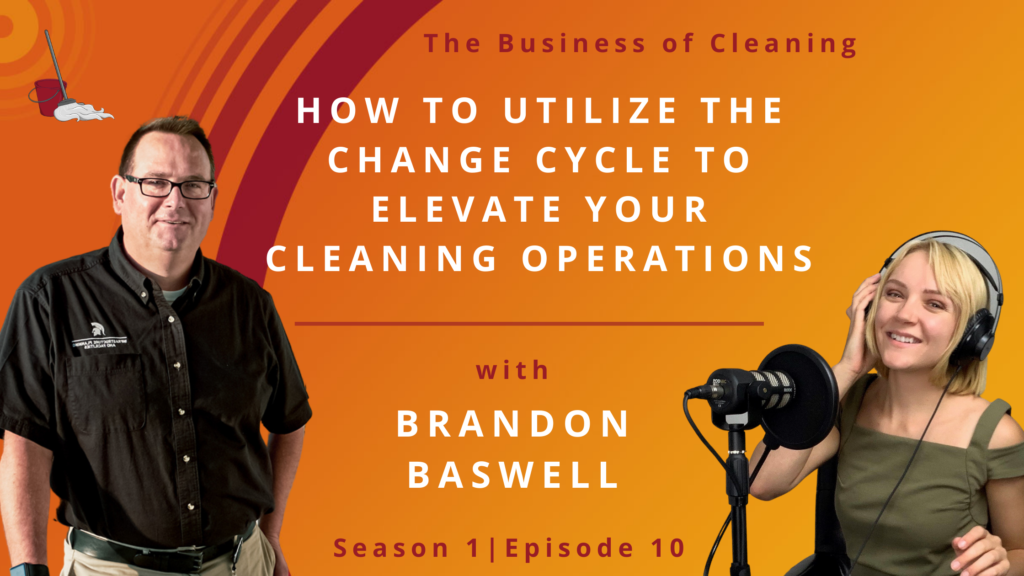Shifting times create a need for an internal shift at one point or another. How does the Chance Cycle help your cleaning operations become more efficient?
In this episode, we break down how to do it successfully no matter if your team is large in size or only a few people.
Click Here To Subscribe On Your Favorite Platform!
About This Guest:

Brandon Baswell
Campus Services Manager - Michigan State University
Brandon Baswell is the Campus Services Manager at Michigan State University and has been in that position for over 16 years. He’s been with the university for over 31 years, meaning he has been there to see many changes and also been part of instigating a major overhaul of how his team operates.
We sat down with Brandon to discuss how to implement a large process change, especially within the cleaning space. It’s not unsurprising that your team or company needs to make changes to keep up with the times, but if that’s a large-scale shift to your processes, it may seem impossible at the start. Don’t worry though, Brandon breaks down the whole change cycle in easy to understand bites.

Podcast Transcription
Halie Morris 0:00
Hello everyone and welcome to the Business of Cleaning podcast.
My name is Halie Morris. I’m your podcast coordinator and host and today I have with me Brandon, do you say your last name, “Baswell?”
Brandon Baswell 0:43
Yes, Baswell.
Halie 0:45
Brandon Baswell. So I’m going to go ahead and actually let Brandon introduce himself and tell us a bit about what he does in his company. So well, actually your university I should say. So Brandon, if you want to?
Brandon Baswell 0:57
I’m a campus services manager at Michigan State University. By area, my biggest part of my job is running the custodial operations. We also have pest control at university events under our area.
But most of my time is spent making sure that our almost 400 workers are out there being effective and providing a healthy environment.
Halie 1:30
So you’ve got quite a bit to manage there, don’t you?
Brandon Baswell 1:34
Yeah, we’re maintaining about 13.5 million gross square feet. That’s scattered over about 110 buildings.
Halie 1:45
Wow. It’s very interesting.
I’ve talked with some people from the school side of times I’ve talked with distributors at this point. But to actually talk to somebody right now, especially with the campus setting is extremely interesting.
Out of curiosity. You’re with Michigan State University, so how are you guys approaching schooling right now with students and with the pandemic going on?
Brandon Baswell 2:12
Well, we were prepared for some limited in-person classes and a lot of emphasis on people doing online learning. Shortly before the semester started. We ended up going to almost entirely online classes.
So on campus, the rate now is that there are very few undergrad classes. Mostly what we still have on campuses are our professional colleges, such as the College of Law. They are still doing some in-person classes and some of the graduate classes are still doing in-person seminars.
We’ve got a vet school, we’ve got a human medicine school, as well as a College of Osteopathic Medicine, those are doing some in-person classes. But in general, the campus is very quiet.
The big part of that is because we’re not having events. We are excited that we’re going to be having some football again starting October 24. That will hopefully help the campus feel a little bit more like fall. That will bring a lot more enthusiasm back to campus just having that thing to rally around.
Halie Morris 3:35
It’s great.
I know, safety is obviously such a big priority right now. But that ability to pull it back and still introduce an activity or introduce a sport that raises morale and keeps students feeling engaged.
This is important because, for some students, this is their first semester or maybe one of their last semesters. They still want to engage at the college level and feel the spirit again.
Brandon Baswell 4:02
That’s a great point. A big part of coming to campus is the whole experience.
Yeah, a lot of people can learn stuff online, you can do that. That’s the end of things, but it is the whole experience of being part of a student group. You know, meeting other people and interacting with people through social exchange.
In a BIG 10 University, the thrill of sports is a part of that experience. I feel bad. You know, there are some groups of students that are missing it and they are at the end of their school year and for seniors, it’s their last year. It kind of was a thud.
Also, you’re right about freshmen this semester. A friend of mine, sent his freshman son from North Carolina to Michigan State this fall. He should have been doing online classes, but because of the nature of being able to have good, reliable internet, and everything, it was necessary for him to come to East Lansing.
He’s still trying to make the best of it. He’s still trying to rush into a fraternity and he’s still trying to get the campus life as much as he can.
Those people who are still using our computer labs are still coming into our buildings and studying and our job is still to provide a healthy environment as much as possible.
Halie 5:41
That’s great to hear, you know. And so from your side, I guess, turning it around, what are some of the efforts that you’re making to make sure that when students come into those shared spaces, that they are safe for them?
Brandon Baswell 5:55
The biggest thing is just a consistent cleaning, a lot of cleaning. With COVID-19, you know, the things that we’ve learned about COVID-19 is that it is not necessarily a strong virus. Once it lands on a surface, it doesn’t survive that long.
We keep hearing the concern “when it’s in the air”. So we’ve done things for air handling, on the mechanical end.
The biggest, most important thing that we can do as cleaning workers is to make sure that we’re giving people a feeling of a healthy environment. They see us cleaning, that we are regularly going around and wiping touchpoints, making sure that the cleaning is visible.
We have a lot more important things happening where people are just constantly walking around, cleaning up touchpoints. But when we have a potential exposure situation, we’re going in and we’re misting disinfectant. We are doing a little bit more of an aggressive cleaning, again, primarily so that people feel safer in the space.
Halie 7:14
Yeah, it’s very good.
It sounds like you’re doing the right things to make it safe and that you’ve really taken a good perspective on what touchpoints you need to address with it.
So with that, you’ve been with the school for a little while, right?
Brandon Baswell 7:32
Yeah, I’ve worked for MSU for 31 years. I’ve been in the cleaning business end now for 23 of those years. So yeah a little while.
Halie 7:48
Just a little bit that’s all…
So with that being said, obviously, our topic for this season, is change management.
We’re coming into a season maybe on a larger scale where students, companies, everybody has seen some kind of shift, some kind of change that’s altered the way they have to go about life.
But for you, this couldn’t have been the first big change or big shift that you’ve seen.
So my question then would be, what is another big shift? Or what is another time that you’ve seen the need to pivot at MSU?
Brandon Baswell 8:29
That’s a great question. I have thought a lot back to 2008 when the economy went really bad. It affected a lot of the funding in higher education, money was tight.
We were put in a position where we took out a severe budget cut, it eliminated a lot of our services at MSU. When we did that we were in a position where we said okay, we need to reinvent ourselves. We can’t survive by just not cleaning offices and just doing everything else we need to restructure the cleaning process at MSU. We needed to go through and really reinvent ourselves.
So really by 2009, we restructured the cleaning process in a wholesale manner. It was really because of that restructure and we were able to be more resilient.
As this most recent challenge came along. We’re like “alright, you know, we’ve got this” we’ve got a good process in mind. We have a system for handling this. We have a system for challenging change and we also get a chance to learn from some of the mistakes we’ve made in the past.
Halie 9:54
No, it’s good to see that you had the precedent. It’s unfortunate to see that you had to go through such a change to do that restructuring in the first place, of course.
But talk me through a little bit about what it was to do that restructuring because obviously, that’s a huge internal change that can be hard to handle. So how did you guys handle it to actually make it so successful?
Brandon Baswell 10:20
What we did was, we basically started by saying, This is what we want to be. We articulated a vision that said, “we want to clean for health, we want to put an emphasis on putting the cleaning worker first,” and give them the best training and the best tools, and establish a consistent process that is going to be repeatable. A process that is going to ultimately have a healthier environment.
So we established a vision, we identified the process, we said, “okay, we’re going to follow this process for doing the work,” we then work loaded into that process, and built job cards, and identified how long it takes to do the work.
After we did that we obviously trained into it. The training was the biggest part. It’s one thing to sit and say, “I’ve got this vision,” but it’s a lot of work to bring it around. When you get to the training, that’s huge, that’s the biggest, most important part of this.
When you say “okay, this is going to be the one best way that we’re going to go forward with our process throughout 110 buildings and 400 different people are going to all do it the same way,”
Say, when you clean a restroom, this is how it’s going to happen. Standardizing the chemicals and standardizing every part of it.
After you’ve got the people trained, the next step is quality assurance, making sure that it’s being done well. We’re getting what we intended to have done. We’re setting up a quality assurance process that checks it. It’s not just supervisors checking, it might be the supervisor checking and making sure that people are doing the job right, that they’re following the process. We call that a team checklist.
It might be that we come back and we actually have a third party that does an inspection and looks to see if we’re following all the key parts of the process, but also is the space clean.
We also survey customers, all of these things give us a way to measure opportunities to measure how well we’re doing and how well the process is working.
Then that is the end of the circle where that then feeds back to the question of “are we accomplishing our vision”. That has been the last 11 years in MSU custodial services. Getting to that point and completing that circle.
Then when I look back on those 11 years, I look back to 2009, I look back at some of the pain we went through. The one thing I really wish I’d put a lot more effort into was saying all of this comes back to the worker. Every step. It would have been critical, it would have been much more successful if we could have linked everything back to “Hey, this is all out to elevate the craft”.
We’re doing all of this to make custodial workers more professional, give us an elevation here. Get better results. But also, improve things. Make this a safer job, make it a more desirable job. Make it a less grungy job by using better tools and techniques.

Halie 14:10
So how long would you say from that initial point when you made that decision to start to settle into the new infrastructure? How long do you think that the initial part took?
Brandon Baswell 14:22
I think it should have taken a lot less.
Initially, when we started out, we really thought “Oh, five years we’ll have this transition done”. But realistically, it was more like 10 years before we really could say “okay, this is the part of our culture now. It is what we are”.
There are still some people that work here that were around and doing things the old way so it took a while to totally change the culture. Like I say, it would have been nice to flip everything in five years. It took, like I said, 10 years before we really were like “okay, we did it.”
Halie 15:13
Do you think that the additional amount of time was maybe just like a perception thing? Or do you think it was because you didn’t at the time go back and relate every step to the employee? Like you had mentioned…
Brandon Baswell 15:29
Nailed it!
I think we could have done it all a lot faster. If we had done a better job, in the beginning, saying, “This is our vision is to accomplish this, this is what we’re going to do” and “This is how we’re going to do it” and “This is how you’re going to perform”. “We’re going to follow up with the measurement”.
If we could have articulated all of this cycle in the beginning and made sure that we linked it all back to elevating the craft in making sure people recognize this is going to make our jobs more successful, it’s going to help you do your job better, it’s going to help create a healthier environment for everybody.
If we could have really articulated that I think we could have moved faster. In the other part of it is that we’re a big department. With that, many people are making the change. We were pragmatic about it.
There had to be some attrition, some people had to move on that weren’t going to be able to come with the new system. That also was part of it. I would say at the five-year mark, we were probably 90% implemented, it really was that last 10% that took us a long time.
Halie 16:54
Yeah, the last push to get settled then.
So with that, I know you mentioned the measurements. While you’ve been able to actually measure your results. When did you decide in that process how you were going to measure or how you’re going to judge your success?
When did you decide this is something we stick with? Or is this something that we reassess?
Brandon Baswell 17:20
Well, you have to figure out what’s worth measuring. What data is going to give you value that you can actually make a decision based on?
There are different data points. in our business it’s still about money. Our people are well paid. The MSU custodians are a part of a collective bargaining agreement and have made a good hourly wage. Plus, they have a generous benefits package. They’re absolutely worth it.
We’ve also been able to demonstrate that we’re getting what we pay for. We get over 58,000 square feet per FTE, clean! Not that it’s total cleanable space, it’s a gross square foot, but we’re able to claim 58,000 square feet per FTE. That’s a really high number.
When I look at a lot of my peers, we’re off the curve on that. So there’s one metric, the next metric is “okay, you’re cleaning 58,000 square feet per FTE, but is it clean?”
It’s looking at the measurements of cleaning. For example, how did we do this? How does this space rate? Are we at an APPA level two? Are we an APPA level four?
When you’re used to using your quality assurance metrics to come back and check and say, “okay, yes, this is a clean space”. Then there are additional metrics.
We have sick time use, becoming a metric that helps you make decisions about how well your policies work. Then you also just have general metrics about supply costs – how much supplies are we spending per square foot?
In our situation, it’s comparing different types of buildings and saying, “Okay, why is our cost per square foot so much higher in this building compared to this other building?” and just looking for those, those little data points to say, “Okay, how can we manage this better?”
Halie 19:37
Alright, also, as somebody who recently went through college, I was very curious about that side, but it’s good to know that part of making a change in a process is measuring it and actually being able to validate those changes you made or know when something is doing well and something is it so establishing those metrics ahead of time
Then knowing exactly what and why you’re measuring something is a huge thing…
Brandon Baswell 20:09
There’s a ton of data out there. It’s how you collect it all. Also what kind of data is useful.
You know, it’s not always, if you can’t really do anything with it, okay, why am I putting the effort into it? And for us, one of the biggest challenges actually has been the collection.
Halie 20:27
Well, some things you say, “okay, we’re gonna measure it,” but it’s not as easy as it sounds.
I know a big thing to look for is employee satisfaction. You have to define employee satisfaction, you have to define what factors within that help you gauge it.
So things like that, which I’m sure are very big, especially when you’re bringing everything back to your employees, you have to be able to nail that down or otherwise, you really don’t have a good picture of what’s going on.
Brandon Baswell 21:03
That’s a great point.
we’re getting ready to put together an employee survey. We’ve done an annual employee engagement survey and it does give us some numbers. But one of the challenges is we’re only able to benchmark against ourselves, it’s not the same survey that’s being done by our peers.
We don’t always have a good benchmark on it. So it gives us some numbers, we can compare how we are this year compared to how we were last year. But it’s not always totally useful. Because again, I can’t benchmark against, you know, ABC cleaning to XYZ University,
Halie 21:54
You really only see if you are improving with how you’ve done prior. A factor that, too, is of course always high employee retention.
Seeing if you can constantly improve that because that’s something that sometimes can be a struggle within anybody in the cleaning industry. It’s a grueling job. So how do you deal with that?
Brandon Baswell 22:20
Yeah, employee retention is a big challenge for us. With our staff, once people get in full time and they’re making a good hourly plus, they got a health benefits program. Yeah, there isn’t much of a turnover.
Generally, people work until retirement or until they move into a new position or something. But the talent development part that we call it, is the temporary staff that comes in. They are the people that we’re developing that can potentially become full-time employees.
That’s where we can have a lot of turnovers. We do watch that, we do measure that turnover, and check the reasons for the turnover to see if that is something that can be fixed because it’s a lot of work to hire people.
It’s a lot of work to train people. We spent an enormous amount of effort on every employee. From the interview, the processing, the onboarding, constant training…that is a big loss of time!
If we don’t manage that person’s satisfaction, they’re not successful and we have to start all over. Sadly, we do that a lot.

Halie 23:50
Sometimes, I think that a part-time role is part of that mindset if somebody comes into a part-time role, it’s not the same level of commitment that you get for somebody stepping into a full-time role.
So it could be extremely crazy. Plus it’s not just a lot of work that you put in, it’s a lot of money and financial headaches that could become a strain if it got out of control.
Brandon Baswell 24:13
It’s a great observation. Especially in this industry, very few people went through school and said, “I want to be a custodian.” People come to this job because there are very few barriers to entry.
It can be a very good and rewarding job. But, it’s still a custodian worker and a lot of people are like, “well, I’m going to do this until I get into the trades or until I finish school and can move on.” It’s not necessarily the end-all. That’s a lot of what you get with the part-time and temporary staff and that’s fine.
Halie 24:55
Just learning that balance of bringing them on and how long you can get them to stay, and enjoy their time working for MSU and with your team.
As we’re kind of wrapping up towards the end here, I did want to ask you, what are some things that others in your industry or others in your shoes doing as far as process changes or restructuring? That could maybe be the big pitfalls for them? Like what are some things to avoid? What are those?
Brandon Baswell 25:39
That’s a good question.
A lot of times people will say, “how did you do what you did?” “How did you restructure your cleaning process?” And I? I say, “okay, we started with a vision”, we said, “Hey, this is what we want to have happened”. We communicated. we articulated. We communicated that vision so that everybody knew what we were trying to get.
A pitfall is if you just say I want to be better.
Another pitfall is if you say, “oh, that won’t work here.” Because then you’re right! You just said it won’t work here so it’s not going to work here. A lot of people looked at our process and said, “it won’t work there.”
I’m like, “Yeah, okay, well, I’m not going to waste your time then”. But if you look at it and say, “how will this work?” or “How can this work best?”. “What is the best way to implement it?”. “How do I make sure that I’m elevating the profession while I do that?”. “How am I making sure that everything ties back to the cleaning?”
Now, the pitfalls that I’m talking about are all the pitfalls I’ve had. The situation that we didn’t always put the cleaning worker first…we were saying, “Okay, this is for the business, this is for the university?”
Well, if we take care of the worker first. If we put the cleaning worker first. It’s then going to take care of itself. If you are constantly in this effort to elevate the craft and make sure people know what they’re doing and know why they’re doing it- you can’t help but be successful.
So, the first pitfall is to know what you want. If you don’t know what you want-okay, there’s a problem. Don’t say what won’t work. Have the mindset of ‘how will this work’ and make sure you’re training people to it. Make sure you’ve got great work loading, before even the training, make sure you have a great workload, and that you’ve got realistic numbers.
That you’ve looked at a process and said, “Okay, this is what can get done in four hours, this is what can get done an eight hours,”
That way you have a consistent standard. A standard not based on your lowest work or not based on your highest work/ A standard based on using ISSA cleaning times or using something like that where you can come back and say this is how it is.
There’s one, the best way for everybody to do it. Your rock stars still might outperform. But you’re also going to have that opportunity to bring up the people who really were underperforming in the first place because now you’re saying, look, we have a standard.
Our standard goes to the middle then in the end, you’re going to have overall improvement.
For you, we keep coming in that circle, I keep saying training! Don’t give up on the training, that’s not a one time deal. The training is constant, the continued making sure that first of all, people know how to be professional. You can’t be a professional cleaner if you can’t elevate the profession. If people don’t know what their tools are called and aren’t constantly calling things by the right name and aren’t doing the right things…
Even with all our training, I still have situations where a custodian, you know, puts a jug of acid cleaner down on top of something and leaves a ring, we still have mistakes. But we train, we learn from those and we make sure we consistently train and say, “Look, you know, this is what you’re working with. This is how it can damage you. This is how it can damage other surfaces”.
When you know better, you’ll do better. Yeah, this is why we want to train.
Halie Morris 29:34
That’s great. That’s a great approach.
I really love your mindset. I know when you were talking you mentioned that putting that standard somewhere at a standard level.
You mentioned bringing up the lower performers versus just cutting them out because I notice some people’s approach tend to be different especially with industries like the cleaning industry that tend to have the higher turnover and they just cut them loose
But, your mindset that I’ve kind of seen throughout this conversation is everybody’s part of that team, you want to bring that person up, you want to get them trained up, and you want to give them the tools and enable them to do their job, which I’m sure helps your business climate and the climate amongst employees tremendously.
Brandon Baswell 30:22
You can’t set a bar if you don’t measure.
You’ve got to know where that bar is. When you set that bar, that gives people a goal, that gives people clear expectations of what they need to do when you give somebody a job card and say, “Hey, this is what you should be able to get done in four hours”. Great. Okay, I like the clear expectation that sets a bar.
You are going to bring me there. There are people that work for us that, you know, we might have been in that place. Now this person is just not going to be successful in the long term. But you’re absolutely right. When we were clear with our expectations and did a better job in the training that made some are lower performers and more successful.
Halie 31:16
You’re not just, explaining, you’re not just setting the standard and communicating.
With that training, you’re coming in and saying, here’s how you do it.
So not only have we set your expectation, but we’ve told you how we’ve taught you how we walked you through it. Now it’s up to you!
Brandon Baswell 31:34
Yeah, Halie. That’s the bottom line. Yes, that’s how it works.
Halie 31:39
I love it.
All right. Well, I think this is a really great place to tie up our episode. So with that being said, Do you have any additional advice that you would like to offer our audience?
Brandon Baswell 31:55
Elevating the craft is the ultimate goal.
The more we do to bring cleaning up, the more we do raise the level of the cleaning worker, the cleaner environment, the healthier environment we’re going to have- the more success we’re all going to enjoy.
Halie 32:15
Well, thank you for that, Brandon.
And thank you to everyone who has tuned in, I look forward to talking to you next week. But before we go, don’t forget to subscribe and leave us a review so we can continuously get better!

